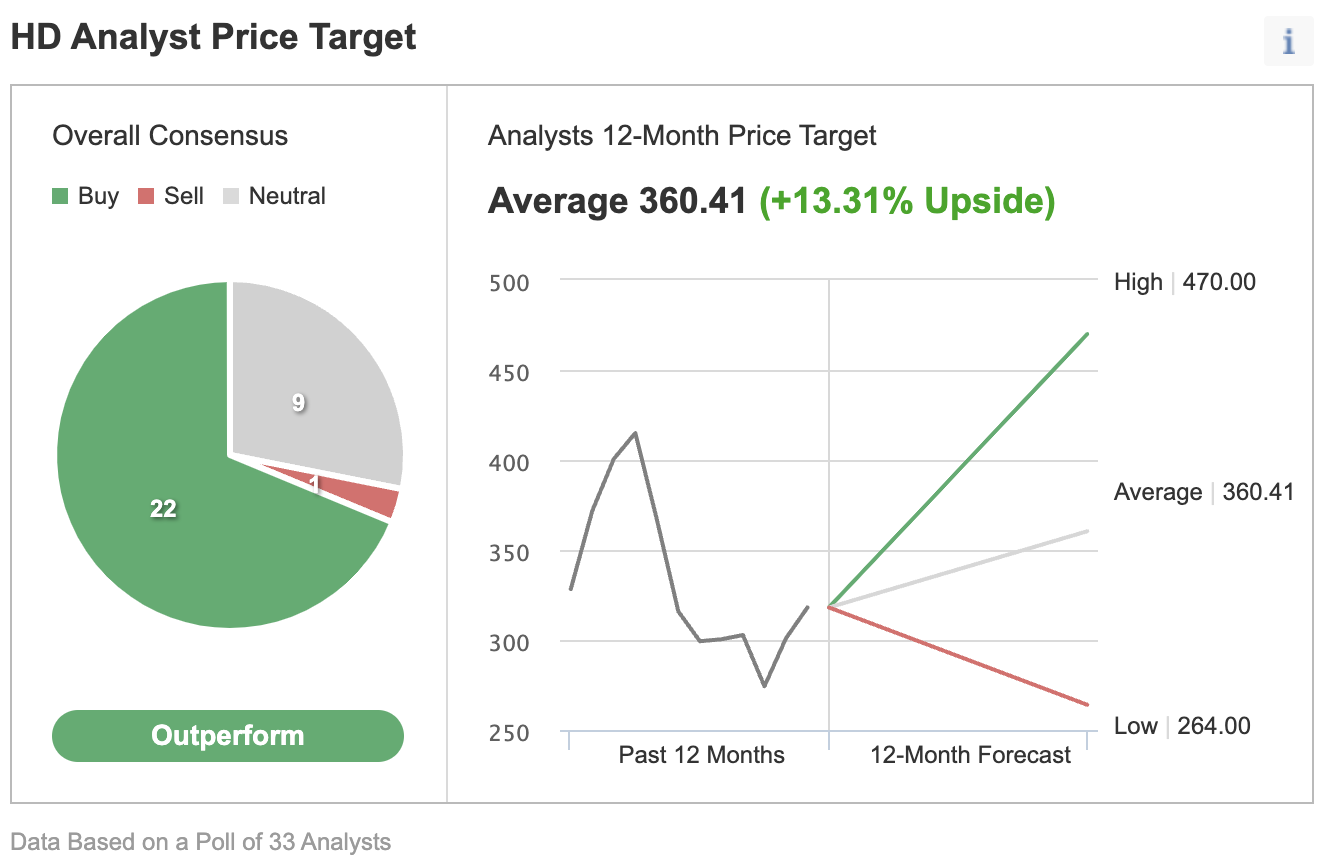- Home Depot has benefited from aspects of the coronavirus pandemic, not least the sharp appreciation in home prices over the past two-plus years
- Down 22% year-to-date, the valuation assigned HD stock is more reasonable—but remains questionable
- Home Depot may simply be such a dominant company that these risks won’t play out, but investors still need to be on guard
In fiscal 2022 (ending January of next year), Home Depot (NYSE:HD) is expected to generate roughly $156 billion in revenue. That comes from the average Wall Street estimate, which in turn is informed by Home Depot’s guidance for same-store sales growth of approximately 3% this year.
In fiscal 2019, Home Depot’s revenue totaled $110 billion, meaning that the company has added approximately $46 billion in sales in three years.
That is a staggering figure. To put it into context, during the past four quarters, Starbucks (NASDAQ:SBUX) generated just $32 billion in revenue. Over the same stretch, Home Depot’s main rival Lowe’s Companies Inc (NYSE:LOW) posted sales of $96 billion—barely twice the dollar growth Home Depot has generated in just three years.
Even in the context of Home Depot’s own history, $46 billion is outstanding. In the decade between FY09 and FY19 (a decade that began amid the financial crisis), Home Depot added only $44 billion in sales. For those ten years, revenue grew at an annualized rate of 5.2%. Over the subsequent three years, growth accelerated dramatically to more than 12% per year.
Is Home Depot A Pandemic Winner?
That step-change in growth begs the question: why isn’t Home Depot considered a pandemic winner?
After all, the massive increase in growth is due largely to factors outside of Home Depot’s control. Indeed, the company continues to execute well. It’s invested heavily and successfully in digital efforts, and its dominance in the Pro segment has kept Lowe’s firmly in second place.
But even second-place Lowe’s has seen sales increase more than 10% annually over the last three years (assuming its consensus estimates for FY22 revenue are roughly correct).
The tailwinds from a strong housing market and flush consumer balance sheets are driving much of the growth for both companies.
High inflation is boosting 2022 sales performance to some extent, but even accounting for that, Home Depot sales have accelerated markedly from their pre-pandemic pace.
That kind of growth simply isn’t sustainable. In fact, Home Depot’s guidance for the year suggests sales are going to slow. Given that revenue increased more than 5% in the first half, full-year guidance suggests second-half growth of less than 2%.
The Case Looking Forward
At more than 19x this year’s earnings, Home Depot stock hardly seems priced for deceleration. Investors and analysts—whose average target price suggests 13.3% upside from the current price—see growth continuing.

There are two core reasons to believe that Home Depot can continue growth going forward, if not at the same pace seen over the past two-plus years.
The first, as an analyst put it on the second quarter conference call, is that the Home Depot business has “re-baselined.” The boost from the pandemic appears to be in the past. From here, the retailer can get back to its pre-pandemic pattern of consistent, if somewhat moderate, revenue growth and profit margin expansion.
The second is that the boom in home improvement spending isn’t necessarily ending. This was essentially the interpretation from Home Depot management on the call. Chief Financial Officer Richard McPhail noted that “the consumers and customers are resilient” even amid inflation. Chief Executive Officer Ted Decker cited an internal estimate that Home Depot customers had seen $8 trillion to $9 trillion in “increased wealth” from home price appreciation over the past few years.
Even high mortgage rates could help Home Depot. As McPhail noted, higher mortgage rates mean customers are more likely to stay in their homes. Given high home equity, that, in turn, leads to steady remodeling demand.
In other words, Home Depot isn’t a retailer like Walmart (NYSE:WMT) or Target (NYSE:TGT), both of which saw an enormous drop-off in demand and a huge rise in inventories as normalcy returned. It certainly isn’t Peloton (NASDAQ:PTON) or other pandemic winners, for which sales plunged sharply from 2020-2021 peaks.
The bull case is that Home Depot, too, is returning to normalcy. And it’s doing so at a time when its customers are in excellent shape. That combination should be enough to drive the growth priced into HD stock.
Be Careful Out There
That bull case, however, seems a bit thin. And the risk is highlighted in a contradiction within McPhail’s argument for the combination of higher equity values and higher mortgage rates.
It’s precisely those higher mortgage rates that are threatening housing prices. It seems a bit too simplistic to say that higher rates mean existing homeowners won’t move because they can’t get the same house for the same monthly payment—and that those existing homeowners will maintain the current home equity.
The bull case for HD stock relies on the housing market staying at least reasonably strong amid higher rates. That may well play out.
But HD stock is a play on a so-called soft landing amid higher rates, higher inflation, and recession concerns. If that soft landing doesn’t arrive, HD stock will most likely have another leg down.
Disclosure: As of this writing, Vince Martin has no positions in any securities mentioned.
